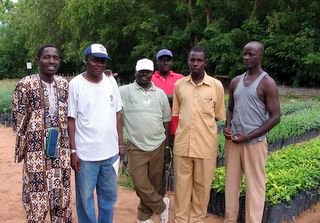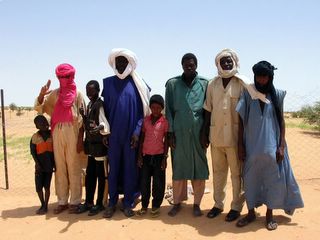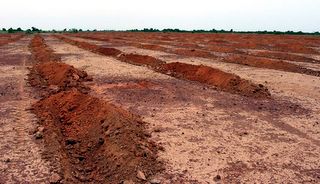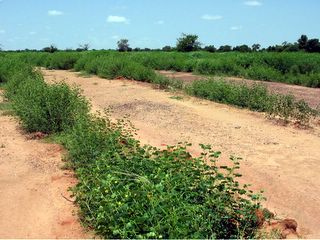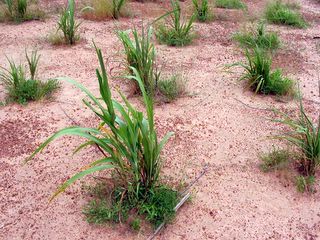|
||||
An Overview of Soil Restoration by DMP Partners in West AfricaLoraine van den Berg The DMP emphasizes mutual learning among member countries through visits and other exchanges. Loraine van den Berg's report gives a valuable consolidated view of activities to combat land degradation in West Africa.
In the course of my Ph.D. study in
South Africa I became curious about how degraded natural areas are
being rehabilitated in the other DMP countries in
Africa. This curiosity led me to visit Senegal,
Mali, Niger and Burkina Faso during 8 August - 2 September 2005. In
each country I met the National DMP Coordinator as well as other DMP
partners and had the opportunity to visit one or more of the DMP
target sites. Senegal The first stop was Senegal where I was introduced to a range of reforestation efforts including tree seedling propagation as well as the establishment of protected areas. We had interesting discussions with representatives of ANCAR (National Agency for Rural and Agricultural Advice) which is a major collaborator with DMP in Senegal. ANCAR mainly focuses on the facilitation of interactions amongst farmer associations, and some of their main activities include the improvement of forages for livestock feed, home gardens and seed production. We also visited a protected area near the city of Koalack where the importance of protecting degraded lands from continued abuse was explained.Our next stop was a soil erosion control project near Yene which is implemented by SOS Environment (NGO in Senegal) in collaboration with ANCAR, Department of Forestry and the Forest Research Institute. Mali After my first introduction to endless big baobabs I ventured
into the wonderful world of date palm trees and crop cultivation
next to the Niger River in Mali. During our trip to Gao I saw large
areas which have been degraded as a result of human and animal
pressure, but was utterly relieved when some restoration work in the
area was pointed out to me. From dunes where Prosopis trees
were planted to stabilize the sand, to areas which were fenced by
communities to improve grazing. At Berrah, close to Gao, the DMP in collaboration with IER (Institute Economic Rural) launched an awareness campaign about the importance of trees, after which the community contributed 20 ha of land to serve as demonstration area. The area was fenced and 30 different tree species (propagated at the research station) were planted. At the DMP site near Bamba (also donated by the local community) a number of activities, including the establishment of African Market Gardens have commenced. From these activities it is evident that with enthusiasm and dedication a difference can be made in the livelihoods of people. Niger The Niger River guided me from Mali to Niger where I spent some
time at the ICRISAT Research Station (Sadoré) near Niamey. It was at Sadoré where I first saw the Sahelian Ecofarm technology. I was impressed at how effectively this system works to harvest rainwater and was not surprised that it is successfully combined with other technologies such as stone walls to reduce run-off loss and further degradation. These technologies are used in conjunction with a warrantage system that allows farmers affiliated with a community based organization (CBO) to store portions of their annual yield at local warehouses, which then serves as collateral on cash loans that farmers use to finance other income-generating activities. We also visited the DMP site at Kouré where restoration
activities are being carried out on a large scale. Mechanical
equipment such as a tractor and ripper are used to break the soil
crust and local villages will be involved in the sowing of
herbaceous species and the planting of trees. The seedlings will be
bought from nurseries in Niamey and these plants will serve as
fodder for livestock but will also provide food for the giraffes
walking about in this region.
Burkina Faso My final stop in West Africa was Burkina Faso where I saw the
results of active conservation and restoration efforts implemented
in the country. I experienced the success of the well known zaï
technology and looked at the practical implication of making stone
walls. In most cases local people are too poor to implement large scale restoration technologies, but will use technologies that do not require a lot of input and money, for example the zaï. We had fruitful discussions with a number of people involved in environmental conservation in Burkina Faso and I had the opportunity to visit the DMP site near Tougouri. Approximately three million tree seedlings have been planted over 100 ha as part of the DMP project, some of them by local villagers to be sold to the project for alternative income generation. Summing Up The trip provided a good opportunity to interact and share knowledge concerning the restoration of natural degraded areas. In each country I saw and experienced elements of restoration which were unknown to me in southern Africa. In most of the cases, the results are extraordinary. I would like to thank the DMP Global Coordination Unit at Niamey, Niger and DMP – South Africa for funding the trip. Special thanks to Dr. Saidou Koala, Dr. Ramadjita Tabo, Dr. Tamba Abdourahmane, Dr. Aly Soumaré, Dr. Mohamadou Gandah, Dr. Souleymane Ouédraogo and all the other DMP colleagues and collaborators who made this wonderful and very informative trip possible.
Return to On the Edge table of contents
|
||||
|

